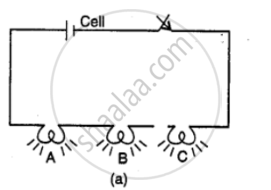Advertisements
Advertisements
प्रश्न
Two bulbs are rated 60 W, 220 V and 60 W, 110 V respectively. Calculate the ratio of their resistances.
उत्तर
Given,
Voltage, V1 = 220 V
V2 = 110 V
Power, P1 = P2 = P = 60 W
As R = `"V"^2/"P"`
`"R"_1 = "V"_1^2/"P" = (220 xx 220)/60`
`"R"_2 = "V"_2^2/"P" = (110 xx 110)/60`
On dividing R1 and R2
`"R"_1/"R"_2 = ((220 xx 220)/60)/((110 xx 110)/60)`
= `4/1`
`"R"_1 : "R"_2 = 4 : 1`
APPEARS IN
संबंधित प्रश्न
All electrical appliances in a household circuit work at the same voltage.
The unit in which we pay the cost of electricity is ..........
One kilowatt is equal to
One day the meter reading is found to be 7643 units while the next day, it was 7657 units. What is the consumption of electricity in a day?
Name the unit in which you pay the cost of your electricity bill. How is it related to joule?
Figure shows two ways of connecting the three bulbs A, B and C to a battery. Name the two arrangements. Which of them do you prefer to use in a household circuit? Give a reason to support your answer.


An electric iron of power 1.5 kW is used for 30 minutes to press the clothes. Calculate the electrical energy consumed in
- kilowatt-hour
- joule.
In a premise 5 bulbs each of 100 W, 2 fans each of 60 W, 2 A.Cs each of 1.5 kW is used for 5 h per day. Find:
- Total power consumed per day,
- Total power consumed in 30 days,
- Total electrical energy consumed in 30 days.
- The cost of electricity at the rate of ₹ 6.25 per unit.
Our body can pass electricity through it.
Sumit does 600 J of work in 10 min and Amit does 300 J of work in 20 min. Calculate the ratio of the powers delivered by them.
